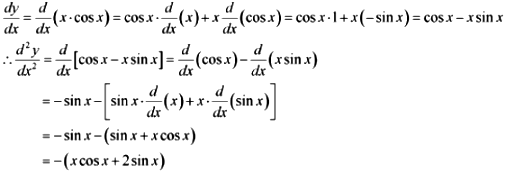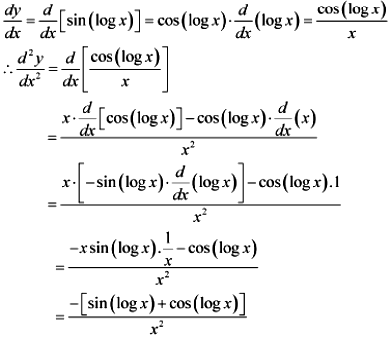84. If x and y are connected parametrically by the equation, without eliminating the parameter, find \(\frac{dy}{dx}\).
\(x = a\left(cos \,t + log\,tan\frac12\right), y = a\,sin\,t\)
Answer:
The given equations are \(x = a\left(cos \,t + log\,tan\frac12\right), y = a\,sin\,t\)

85. If x and y are connected parametrically by the equation, without eliminating the parameter, find \(\frac{dy}{dx}\).
x = a secθ, y = b tanθ
Answer:
The given equations are x = a secθ, y = b tanθ

86. If x and y are connected parametrically by the equation, without eliminating the parameter, find \(\frac{dy}{dx}\).
x = a(cosθ + θsinθ), y = a(sinθ - θcosθ)
Answer:
The given equations are x = a(cosθ + θsinθ), y = a(sinθ - θcosθ)

87. Find the second order derivatives of the function.
x2 + 3x + 2
Answer:
Let y = x2 + 3x + 2
Then,

88. Find the second order derivatives of the function.
x20
Answer:
Let y = x20
Then,

89. Find the second order derivatives of the function.
x.cosx
Answer:
Let y = x.cosx
Then,

90. Find the second order derivatives of the function.
log x
Answer:
Let y = log x
Then,

91. Find the second order derivatives of the function.
x3 log x
Answer:
Let y = x3 log x
Then,

92. Find the second order derivatives of the function.
ex sin5x
Answer:
Let y = ex sin5x
Then,

93. Find the second order derivatives of the function.
e6x cos3x
Answer:
Let y = e6x cos3x
Then,

94. Find the second order derivatives of the function.
tan-1 x
Answer:
Let y = tan-1 x
Then,

95. Find the second order derivatives of the function.
log(log x)
Answer:
Let y = log(log x)
Then,

96. Find the second order derivatives of the function.
sin(log x)
Answer:
Let y = sin(log x)
Then,

97. If y = 5cos x - 3sin x, prove that \(\frac{d^2y}{dx^2} + y = 0\)
Answer:
It is given that, y = 5cos x - 3sin x
Then,

Hence, proved.
98. If y = cos-1 x, find \(\frac{d^2y}{dx^2} \) in terms of y alone.
Answer:
It is given that, y = cos-1 x
Then,

99. If y = 3 cos(log x) + 4sin(log x), show that x2y2 + xy1 + y = 0
Answer:
It is given that, y = 3 cos(log x) + 4sin(log x)
Then,

100. If y = 500e7x + 600e-7x, show that \(\frac{d^2y}{dx^2} = 49y\)
Answer:
It is given that, y = 500e7x + 600e-7x
Then,

Hence, proved.
101. If ey(x + 1) = 1, show that \(\frac{d^2y}{dx^2} = \left(\frac{dy}{dx}\right)^2\)
Answer:
The given relationship is ey(x + 1) = 1

Taking logarithm on both the sides, we obtain

Differentiating this relationship with respect to x, we obtain

Hence, proved.
102. If y = (tan-1 x)2, show that (x2 + 1)2 y2 + 2x(x2 + 1) y1 = 2
Answer:
The given relationship is y = (tan-1 x)2
Then,

Again differentiating with respect to x on both sides, we obtain

Hence, proved.